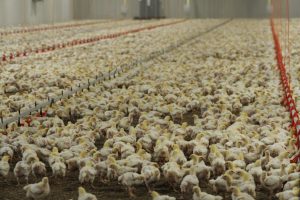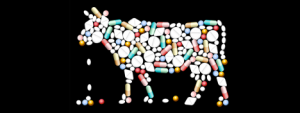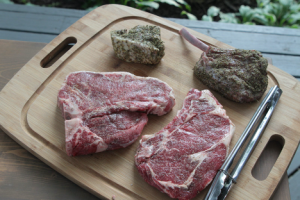Surf & Turf: Uncovering The Meat Industry
The Meat We Eat
Thomas Pawlowski

This is our food production nowadays. We all remember the first time we were told of this reality, though we banish this knowledge from our daily thoughts. Our standards of the food we buy have risen greatly in the past years, and for many good reasons. Whether it has been to make our food production more environmentally sustainable, to help protect the rights of animals with ethically raised meat, or even for supporting local farmers, we have been willing to pay more for the benefits we consider worthwhile. But what about our health? Putting the morals of the meat industry debate aside for this discussion, does it physically matter where your meat comes from, and how it is raised? We know that pesticides can accumulate throughout the food chain and result in hormonal and body function disruption, but what does it mean to us physically if we eat animals raised with antibiotics, or kept in cages their entire lives and given corn-feed? The following article will follow the exact science of the consequences of eating food that falls into these “unhealthy” categories.
To understand why our meat is produced as such, it is important to know the role corn and antibiotics play in the meat we eat. Corn-based feed replaced the iconic grazing plains of cattle and the vegetable-based diet of our chickens for two primary reasons. The first one was that it is incredibly cheap, cheaper than owning and maintaining the massive amounts of land that cattle require to graze on. The second was that it caused the animals to gain weight faster. Incredibly high in carbohydrates, this diet has the same effect as eating spaghetti every night instead of a salad would on us. These animals gain weight incredibly fast, which if you’re a farmer raising animals for slaughter it means you will be able to sell more meat from these cows in less time than it would normally take through feeding your livestock a grass diet.
The antibiotics came into play when these animals shifted from an outdoor, grazing lifestyle to a more sedentary life inside the factories that is now the common situation of the American farmer. With all these animals stacked up next to each other, diseases ran rampant. Farmers fixed this by feeding these animals copious amounts of antibiotics ensure these animals stayed healthy until they reach maturity.
This change in the image of the American farmer was not well received. It was hard to stomach that our American farmland, which we thought of as full of content animals and manned by a good natured old man who would build a baseball field in his cornfields if Shoeless Joe Jackson told him so, was now an industrial factory producing meat in the most economical, corporate way possible. Talk show hosts, health gurus, and mothers alike warned of the dangers of eating these “mass produced” animals. This message has been heeded by a large number of people. I questioned my friends, family, and classmates about the importance they put on where their meat comes from and why, and although there is an admittedly small sample size (where the number of participants was 53, and definitely not representative of the general population), the results agree with this assumption. On a scale of 1-10, with 1 being never at all and 10 being would not buy any other kind of meat, people ranked their preference of paying extra for organic meat as a 7.6. They also put their preference for antibiotic-free animals at a 6.3, and the most popular reason stated was “personal health reasons”, with the second response being “environmental/moral reasons”. Interestingly enough, the preference of grass-fed vs corn-fed was the lowest scoring, with an average value of 3.4.
…… So what? Isn’t a cow just a cow, no matter what it eats?
I remember asking myself this question when I was warned of these animals. I knew it wasn’t good for the intrinsic life of the animal, but if I could get past this moral dilemma my body would process this “tainted meat” just the same as it would another chicken or cow, right? Aren’t these animals all just same unique combination of carbon, hydrogen, and oxygen atoms that give us chicken, or beef? To figure this health hazard out, I first decided to tackle the antibiotics question
The Antibiotics Question:

How bad is it really to eat animals more drugged up than Ozzie Osborne? The answer is not so simple, as with most things concerning our health. According to the CDC (2020), all meat put on the production line cannot have any antibiotic residues in them at the time of slaughter. This means even with the animals given antibiotics, they must be kept alive and antibiotic free for enough time to where there is no trace of the antibiotics in the meat at the time of slaughter. So for anyone that is concerned about consuming medication through your meat, worry no longer.
This one standard does not mean there is no danger, however. While there are no antibiotics in these meats, its’ presence is still felt during the animal’s lifetime. The constant usage of antibiotics causes an arms race with the bacteria. It evolves to counter the antibiotics, which is where new antibiotics will be subscribed and the bacteria will continue to evolve, and so on until the animal is set aside for slaughter. While the antibiotics may be gone by that time, the bacterium is still present in the meat and this highly evolved bacteria can pose a threat to humans. The consequence of this bacterium is seen with the 600,000 cases of bacterial infection caused by meat consumption every year (ConsumerReport, 2020). Now it is important to note that the risk of disease can be mitigated by properly cooking meat, but there is still a somewhat reasonable chance one could get sick. However, the risk is worsening as bacteria resistance is getting more and more resistant to the plethora of antibiotics used on animals.
So, while antibiotics may not have a drastic negative effect on our health and are safe to consume, they are contributing greatly to a growing problem of antibiotic resistance. So how can one avoid it then? It may be harder than you think, as the labels are intentionally misleading. Through my trips to the grocery store, I counted four different antibiotics labels. There was “raised without antibiotics”, “no critically important antibiotics used”, “no human antibiotics used”, and even “no growth promoting antibiotics used”. While the literal meaning can be understood very easily, the health implications of each one is still unknown. The golden rule, as shown by Consumer Report (2020) for a label is to only buy the “raised without antibiotics” or “no antibiotics used, ever”. While these other labels may be technically telling the truth, the effect of limiting their antibiotics is negligible, and not actually preventing these resistant bacteria from forming. Even if the antibiotics are animal specific or not critically important, they are still causing the growth of resistant bacteria inside the animal, which can very potentially cross over to human beings.
So it turns out the antibiotic raised animals might not be immediately harmful, but what about corn-fed animals?
The Feed Question:

“You are what you eat” has been a phrase we’ve all heard throughout our lives (and one that still doesn’t make sense to me). Has what we are changed then? Decades ago, the animals we ate would have grazed on the plains, eating a healthy dosage of grass, alfalfa, and other natural vegetation. Nowadays they most likely eat a processed grain feed, a pure carbohydrate meal designed to fatten the animal as quick as possible. Has this diet change come to impact us at the top of the food chain?
According to the scientists, yes there is, although it will only make a noticeable difference for certain people. Research Rachel Elsywk concludes in her article “Impact of grass/forage feeding versus grain finishing on beef nutrients and sensory quality: The U.S. experience” (2013) that “in the U.S., comparable lean beef cuts from cattle consuming mostly grass/forage appear to be lower in fat than those from grain-finished beef, largely at the expense of MUFA” (monounsaturated fatty acids, an important fat we need). This makes sense, as a cow eating lean plants and vegetation walking around all day will be significantly leaner than one eating a pure carb diet, sitting in a shed gaining weight at a breakneck pace. But is the fat content the only difference? If so, it wouldn’t make too much of an impact, assuming one isn’t eating meat for every meal. It’s important to look at the beef on a molecular level, the proteins and fats that make up our meat.
Scientist Cynthia Daley published the following report in the Nutrition Journal (2010), “Research spanning three decades supports the argument that grass-fed beef (on a g/g fat basis), has a more desirable SFA lipid profile (more C18:0 cholesterol neutral SFA and less C14:0 & C16:0 cholesterol elevating SFAs) as compared to grain-fed beef… Grass-fed beef is also higher in precursors for Vitamin A and E and cancer fighting antioxidants such as GT and SOD activity as compared to grain-fed contemporaries.” The term “SFA lipids” come to mean “saturated fats”, which is the healthier type of fat we need in our diets. This report comes to show us that grass-fed beef has lower fat content, and the fats in these meats are ones that are healthier for the body and not stored as the body fat we imagine when we hear the word. The other trace minerals and vitamins seem to be more plentiful in the grass-fed beef as well.
Now it is important to note that both articles did mention that grain fed beef was also a significant source of nutrients and could be a healthy addition to the diet, so it would be premature to call grain fed meat objectively bad. It seems to be that as a treat, the meat from the animal is slightly less nutritious, but not devoid of any minerals. If you are eating beef or chicken for flavor and not for purely nutritional value, then buying the grain fed version will not be incredibly detrimental. It is important to say though that there was a significant difference in Omega-3 Fatty Acids, which is an essential acid used by our brains, and a key component in decreasing inflammation throughout the body.
But just to be sure there wasn’t any significant health differences, I interviewed my father, Dr. Pawlowski about these issues discussed. An urgent care physician with experiences in the E.R. and family practice, finding the right diet to ensure there wasn’t a return visit to the hospital has been a common occurrence for him. His thoughts on the antibiotic usage and grain-based diets of our consumption animals were as follows. “Organic and grass-fed meats raised without antibiotics are definitely preferable to people with cardiovascular needs, as the meat is much higher in Omega-3 fatty acids…..However, these people represent a small portion of the population, and the average healthy person will notice no difference eating either of these two types of meats.”
To succinctly summarize then, it seems that while healthier, the antibiotic, grass fed meat may in fact not actually make a significant difference in the health of the majority of us. I would like to point out that this article is only covering the human health aspects of the meat we eat. There are many reasons to choose the more expensive, antibiotic and grain free meat. People choose to do so every day to promote ethical animal practice, to prevent antibiotic resistance, and for their own medical reasons. These are all valid and important causes to consider. But for those who have been justifying their more expensive consumption with the rationale that it was significantly benefitting their health, it turns out that may not truly be the case.
References
Calvo, T. (2020, September 10). What ‘No Antibiotics’ Claims Really Mean. Retrieved November 21, 2020, from https://www.consumerreports.org/overuse-of-antibiotics/what-no-antibiotic-claims-really-mean/
Daley, C. (2010). A review of fatty acid profiles and antioxidant content in grass-fed and grain-fed beef. Nutrition Journal, 9(10). doi:10.1186/1475-2891-9-10
Elswyk, M. (2014). Impact of grass/forage feeding versus grain finishing on beef nutrients and sensory quality: The U.S. experience. Meat Science, 96(1), 535-540.
Food and Food Animals. (2020, October 23). Retrieved November 19, 2020, from https://www.cdc.gov/drugresistance/food.html
Pawlowski, T. (2020, November 17th, 2020) [Phone Interview]
